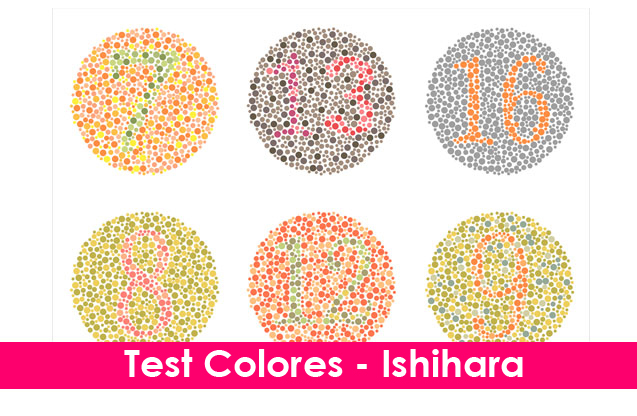COLOR BLINDNESS
Color blindness is a genetic defect which causes difficulty in distinguishing colors. The degree to which a person experiences it can vary greatly and ranges from an inability to discern any color (achromatopsia), to a mild degree of difficulty to distinguish some shades of red, green and occasionally, blue. Color blindness can be detected by carrying out specific visual tests such as the Ishihara test.
Cones are cells which are sensitive to light and which are to be found in the retina in the so-called photoreceptive layer. These cells are responsible for us being able to see in color.
Ishihara color test.
In human beings and in many other primates there exist three types of cones, each one of which is sensitive in a selective way to the light of a specific wavelength, green, red and blue. The brain interprets the colors based on the stimulation of these three types of cones. The combination of these three basic colors, red, green and blue allow us to differentiate numerous shades. The human eye can perceive around 8,000 colors and shades with a specific level of luminance. It is in the brain that this interpretation takes place.

The genetic defect is hereditary and is generally transmitted through a recessive gene linked to the X chromosome. If a male inherits an X chromosome with this deficiency he will be color blind. However, in the case of females, who possess two X chromosomes, they will only be color blind if both of their X chromosomes have this deficiency. For this reason, color blindness affects approximately 1.5% of the male population and only 0.5% of the female population. There exist different types of color blindness:
- Achromatic: The individual has none of the three types of cones or none of them function. Only one in every 100,000 people are affected in this way. It is the most severe form of color blindness and means that the sufferer is only able to discern differing shades of gray
- Monochromatic: People who have this type of color blindness have only two types of cones and because they have one of the cell types missing, the other will take charge of receiving the stimuli which corresponds to the first one. There can be three types : Protanopia, deuteranopia and tritanopia.
- Protanopia: This consists in a total absence of red retinal photoreceptors.
- Deuteranopia: This is the absence of green retinal photoreceptors
- Tritanopia: This is highly unusual and is when the blue retinal photoreceptors are absent.
- Tricromático anómalo: The person affected has the three types of cones , but with functional defects, which means that they confuse one color with another. This is the most common and abundant group of color blindness sufferers. They have the three types of cones but perceive the shades of color in an altered form. They usually have similar defects to people who have dichromatic color blindness but to a lesser degree.
